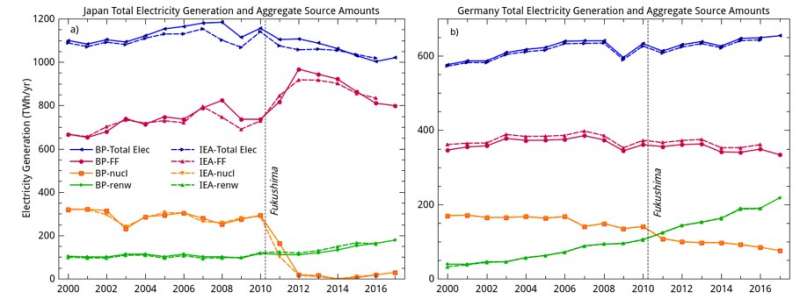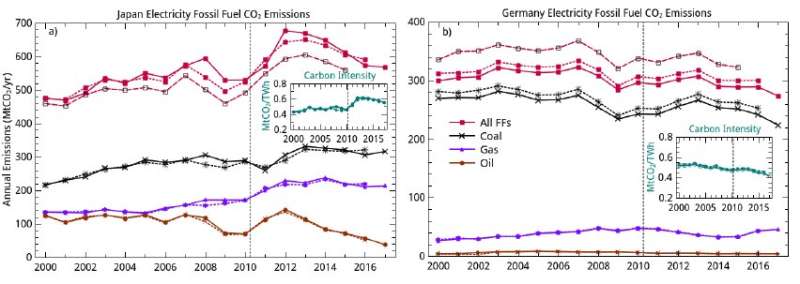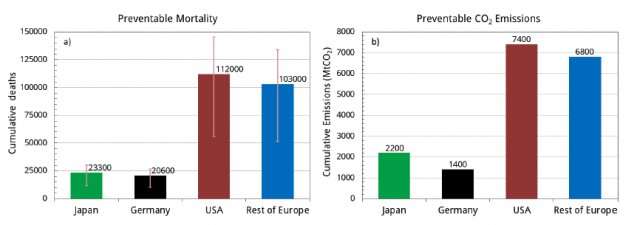How energy choices after Fukushima impacted human health and the environment

After the March 2011 nuclear power plant accident at Fukushima, Japan, nuclear power output experienced a rapid and large decline in that country as well as Germany. Although the specific reasons for this decline differed between the two countries, it is clear that antinuclear public attitudes were a major factor. Soon after the accident, Germany announced plans to completely phase out its remaining nuclear by 2022.
In paper published today in Energy Policy, we analyze the nature and implications of energy, electricity and CO2 emission changes in Japan and Germany after Fukushima. We also examine how emissions and mortality would have been impacted had these countries reduced their coal and natural gas power output by the same amounts as they reduced nuclear. Lastly, we analyze the potential effects of a complete phaseout of nuclear power in the near-future (2018-2035) for Germany, the U.S., and the rest of Western Europe, where economic factors as well as public policies and sentiment are currently unfavorable toward nuclear power.
Consistent with prior studies, we found that the drastic cuts in nuclear power in Japan and Germany led to increased CO2 emissions in the first three years after Fukushima due to higher fossil fuel usage to compensate for lower nuclear power output. This phenomenon has received widespread international media attention.
However, the good news (which has received less attention) is that since 2013, both countries have achieved an overall reduction in their emissions. This was somewhat surprising, as nuclear power was a major non-fossil electricity source in these countries. We suggest that this result stems from record-high renewable power increases and lower or steady total energy use. We also note that although Japan's electricity sector emissions remain higher than in 2010, i.e. before Fukushima, the government plans to bring the share of electricity from nuclear back to pre-Fukushima levels and reduce the share from fossil fuels, both of which will help lower emissions.

Now the not-so-positive news: Our hypothetical scenarios show that if Japan and Germany had reduced coal instead of nuclear after Fukushima, they could have together prevented about 28,000 air pollution-induced premature deaths and 2.6 billion tons of CO2 emissions between 2011 and 2017. Thus, these countries' post-Fukushima energy choices have resulted in major levels of avoidable impacts of the accident.
These lost opportunities will make it even more difficult to achieve national climate change and air pollution mitigation goals, which are already demonstrably inadequate. However, useful lessons can be learned from them—most notably, the prime importance of targeting fossil fuels for reduction instead of (or at least, before) a major non-fossil source like nuclear. For example, Germany can still avoid up to 16,000 premature deaths and 1.2 billion tons of CO2 emissions if it curtails coal power instead of eliminating its remaining nuclear power as planned. Likewise, the United States and the rest of Western Europe can each avoid over 100,000 premature deaths and about 7.7 billion tons of CO2 emissions if they, too, focus on reducing coal rather than nuclear.

More information: Pushker A. Kharecha et al. Implications of energy and CO2 emission changes in Japan and Germany after the Fukushima accident, Energy Policy (2019). DOI: 10.1016/j.enpol.2019.05.057
Journal information: Energy Policy
Provided by Earth Institute, Columbia University
This story is republished courtesy of Earth Institute, Columbia University http://blogs.ei.columbia.edu.





















